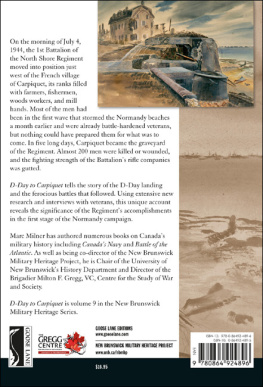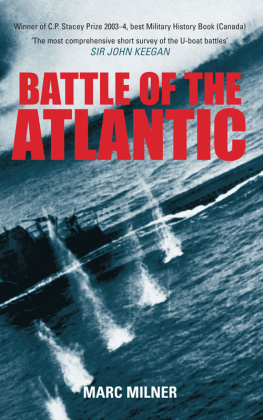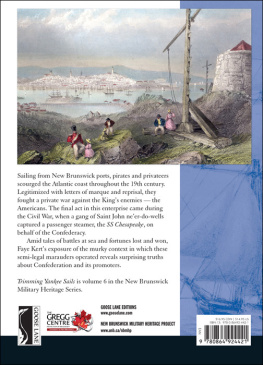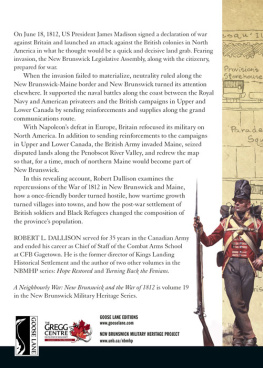Copyright 2010 by Marc Milner and Glenn Leonard.
All rights reserved. No part of this work may be reproduced or used in any form or by any means, electronic or mechanical, including photocopying, recording, or any retrieval system, without the prior written permission of the publisher or a licence from the Canadian Copyright Licensing Agency (Access Copyright). To contact Access Copyright, visit www.accesscopyright.ca or call 1-800-893-5777.
Edited by Brent Wilson and Barry A. Norris.
Front cover illustrations by John Horton (upper) and Irwin John Bevan (lower).
Spine photograph from www.sxc.hu.
Back cover illustration from http://www.saintjohn.nbcc.ca/heritage/rcn/ship_building.htm.
Cover and interior page design by Jaye Haworth.
Art direction by Julie Scriver.
Library and Archives Canada Cataloguing in Publication
Milner, Marc
New Brunswick and the navy: four hundred years / Marc Milner, Glenn Leonard.
(New Brunswick military heritage series; 16)
Includes bibliographical references and index.
ISBN 978-0-86492-632-6
1. New Brunswick History, Naval. I. Leonard, Glenn, 1962- II. Title. III. Series: New Brunswick military heritage series; 16
FC2470.N3M54 2010 971.51 C2010-903102-4
Goose Lane Editions acknowledges the financial support of the Canada Council for the Arts, the Government of Canada through the Book Publishing Industry Development Program (BPIDP), and the New Brunswick Department of Wellness, Culture and Sport for its publishing activities.
Goose Lane Editions Suite 330,
500 Beaverbrook Court
Fredericton, New Brunswick
CANADA E3B 5X4
www.gooselane.com
New Brunswick Military Heritage Project
The Brigadier Milton F. Gregg, VC,
Centre for the Study of War and Society
University of New Brunswick
PO Box 4400
Fredericton, New Brunswick
Canada E3B 5A3
www.unb.ca/nbmhp

New Brunswick and the Navy
New Brunswick Military Heritage Series, Volume 16
Contents
Early Days
New Brunswick at War, 1812-1814
Navies and the New Dominion
The Second World War
New Brunswicks Navy at War, 1939-1945
Building the Modern Fleet, 1945-2003
On May 4, 2010
Dedicated to the Canadian Navy
in Honour of Its Centennial
Introduction
On July 26, 1881, H.M.S. Charybdis cast anchor in the harbour at Saint John, New Brunswick. The warship, just acquired by the young Dominion of Canada, represented the first attempt to establish a Canadian navy. Her presence in that bustling Maritime city was no accident. In the late nineteenth century, Saint John was Canadas premier east coast port, one of its busiest commercial ports, and the only major one ice-free year-round. Charybdis might have gone to Halifax, where there already was a naval base, but that establishment belonged to the Imperial navy. Saint John seemed the logical place to found a new Dominion naval service. But by the time Canada tried again, in 1910, the Royal Navy was gone from Halifax, and Canadas permanent naval service would be founded there, not in Saint John.
Over the past century historians have traced the roots of Canadas navy through the legacy of the former Imperial base in Halifax the Warden of the North, as it was once known. Through two world wars and a long Cold War, much of the Canadian navys history was made in the broad ocean far from New Brunswicks sheltered shoreline.
But New Brunswicks role in Canadian naval history is greater than one might suppose. Canadas navy calls Halifax its home, but most of the fleets key vessels in the navys centennial year were built in New Brunswick. So, too, was Canadas National Naval Memorial, H.M.C.S. Sackville : the iconic warship of Canadas formative naval experience in the Battle of the Atlantic. She is the last of nearly three hundred corvettes hastily built around the world for auxiliary duty in the Second World War and the vessel that made Allied victory in Europe in 1945 possible. Preserved in Halifax, she is the monument to those who fought in the greatest war at sea and a symbol of the nations decisive contribution to victory. She is even named for a New Brunswick town.
New Brunswick can boast a number of other singular accomplishments in the annals of Canadian naval history: from the first naval war in Canadian history in the 1640s; to the little-known Battle of the Restigouche in 1759; to native son Caleb Seeley, who became one of Canadas most successful privateers in the War of 1812; to Sir George Foster, the New Brunswicker whose resolution in Parliament on March 29, 1909, led to the Naval Service Act of 1910; to the founding in 1944 of the Canadian navys first oceanographic research station. Amid all this, New Brunswick also made its own largely neglected and little-known naval history. The provinces land frontier might have been largely quiet during the War of 1812, but New Brunswickers established their own navy and fought a relentless small ship war in the Bay of Fundy and Gulf of Maine for years. In the twentieth century, New Brunswick raised naval reservists and operated Canadas busiest defended commercial port and the British Empires largest dry dock, while the navys ships carried provincial place names to war and made some remarkable history. The century culminated in the building of the Canadian Patrol Frigates that form the core of the contemporary Canadian navys combat power. This is the story of New Brunswick and the navy.
Chapter One
Early Days
New Brunswick is bounded on three sides by the sea, with excellent harbours and, generally, an accessible shoreline and navigable rivers. It is not surprising, then, that much of its recorded history involves the sea and ships. Indeed, it is now accepted among specialists that the eastern shore of the province is the fabled Vynland of the Norse Sagas. Icelands Saga Museum displays a map showing the site of Leif Ericksons tenth-century explorations as Miramichi Bay, and it is believed that a sod house comparable to that discovered at LAnse aux Meadows, Newfoundland was established there. This temporary Norse intrusion speaks to the nature of New Brunswicks maritime and naval history: echoes of larger events washing ashore when and where occasion allowed.
Although permanent settlement of New Brunswick by Europeans did not occur until the seventeenth century, European fishermen began exploiting the area in the sixteenth century. By the time Samuel de Champlain arrived in 1603, local Aboriginals were already sailing the Bay of Fundy in small, open, European-designed chaloups and were equipped with steel weapons of European manufacture. Champlains voyage of exploration took him down the Atlantic coast from the St. Croix River to the Saco River, accompanied by both a Mikmaq and a Maliseet chief, each sailing in his own vessel. Once south of the Saco, Champlain discovered a sedentary agricultural people who still worked with stone tools. As historian Tony Kennedy has observed, By adopting European coastal vessels and styles of navigation, the Mikmaq and Maliseet had become regional middlemen, transporting furs from the Gulf of Maine to more profitable markets in the Gulf of St. Lawrence. They made extensive use of European ships and weapons to enforce their interests within the region.
It was, therefore, the transfer of technology by Basque whalers and fishermen harvesting the resources of the Gulf of St. Lawrence that prompted the first recorded maritime war in Canadian history. The origins of the Tarrentine War, fought by the Aboriginal people of the area between 1603 and 1619, lay in the struggle to control access to this new technology and the desire to avenge the killing of some prominent Mikmaq and Maliseet chiefs. In 1603, open warfare erupted between a confederacy of these two tribes led by the Mikmaq chief Membertou and their rivals in southern Maine and New Hampshire led by the Penobscot chief Bessabes. Membertous confederacy was armed, in author Dr. Olive Dickasons words, with swords, cutlass, and even muskets, as well as steel arrowheads and knives. While raids occurred overland and along river systems, the Mikmaq-Maliseet confederacy also used 12-ton, forty-foot-long chaloups as troop transports and supply ships. One Jesuit account commented that they handled them as skilfully as our courageous and active sailors in France.
Next page














